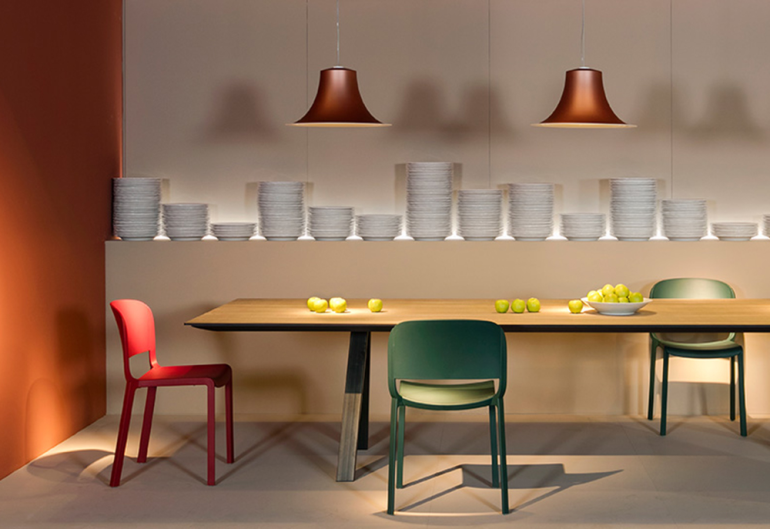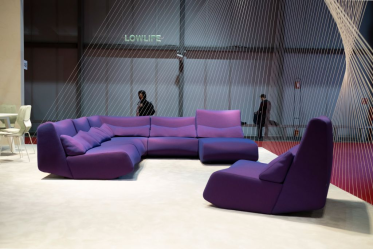
The Arki-Table by Pedrali comes in various lengths to suit any situation.
Whether you are renovating or building a new home – when it comes to tables, there is a surprising amount to talk about and it is more than just 'do we want round or rectangular?'
The first question to ask yourself in deciding on a new dining table is where is it going and how many people does it need to seat? That might seem obvious but in fact the answer to these questions will inform everything from the shape to the type of legs you will land on.
Ultimately the size and proportion of your dining space will define the table you invest in, and as a general rule of thumb you should allow at least 800mm between the edges of the table top and any surrounding walls, doors or furniture. Combine that with an ideal table depth of just over one metre and you pretty soon get the picture that a comfortable dining area will consume three metres of floor space in either direction.
The other thing to consider in this equation is that the ideal portion of seating space per person needs to be 600mm. For rectangular tables that maths is pretty easy, though you should allow an additional 600mm on each end for those seated at the heads of the table. Without getting the calculator out, for round dining tables a diameter of 1200mm will comfortably seat 6 and for 8 you should be looking at 1600mm.
From there it comes down to the legs as nobody likes bashing their knee on a hard corner or stubbing their toe as they excuse themselves from a meal. Pedestal tables like the Eero Saarinen’s 1957 circular classic are ideal though the stability relies on the quality of the manufacture given the amount of pressure on the central point.

The Viggo table removes the need for a sub-frame through joining the legs at two separate spots.
Similarly, tables like Pedrali’s Arki-Table are a good option because the legs spread from the centre of the table meaning more room above your legs as there is no sub-frame to support the straight legs found in more traditional table settings. The Viggo table by Danerka also lacks a sub-frame but achieves stability through each leg being split, attaching at two points to the table top for strength.
The added benefit to these is they are easier to customise and come in a range of dimensions as the tops are almost interchangeable.
Speaking of customisation, this is where things can get really interesting and make your investment completely unique to your home. Across Australia there are a multitude of furniture makers who specialise in custom tables or custom versions of their existing designs. Finding a local maker not only supports the people in your area but it means you can be a part of the process and saves on shipping costs.
These skilled craftspeople generally work in solid timber and can advise you or even help you care for your commission over the years to come. Every timber can mark or stain but that doesn’t mean it is there forever and the key to protecting a timber table top is in the finish.
Forget polyurethane or two-pack coatings – once marked there is no turning back. With oils like Osmo, the timber not only looks and feels like timber, scratches can be removed through some gentle sanding and reapplication.

Tom Fereday's flat-packing Louis table for Mast Furniture.
In thinking about the size of your room, the size of a table and the anticipation of your first dinner party, the one thing not to forget is how you will actually get your table into your home. This may seem like a no-brainer but we’ve all had a friend who has been stuck in the stairwell with a sofa or a bookshelf trying to move into an apartment, and tables are no different.
Larger square and round tables are difficult to get through small spaces and doorways while longer tables don’t seem to like turning tight corners. In these cases flat-pack tables are a good idea – companies like MAST Furniture in Queensland have recently put into production the Louis table by Sydney-based Tom Fereday. Initially developed for the Louis Vuitton Sydney store, the solid timber table oozes style, packs flat and can be customised.

A focus on timber and solid construction were the drivers behind the Louis table.
It goes without saying that some of these things are logical and some necessary, but the basic principles of deciding on a table that will suit your space, style and wallet can be flipped on their head to inform the design of the space itself. In speaking to an architect or interior designer, there is absolutely nothing wrong with saying, 'We actually want a sixteen- seater dining room table'. Like being stuck in the lift with a three-seater sofa, it happens more that you probably think.
_
Pedrali and Danerak are exclusive in Australia to Interstudio.
WRITTEN BY HouseLab








